Papers by Mark Dell'Acqua

Biophysical Journal, 2015
are complex and may differ among tissue-specific isoforms nevertheless, mechanistic understanding... more are complex and may differ among tissue-specific isoforms nevertheless, mechanistic understanding of the molecular regulation of the channel is beginning to emerge. We and others have demonstrated the importance of the carboxyl terminus (CT) in the regulation of the channel. The CT is a hot spot for mutations that produce inherited cardiac arrhythmias, myotonias, epilepsy and autism. In the case of NaV1.5, the cardiac channel, mutations of critical structural motifs in the CT (including an EF hand-like motif and an IQ motif) result in disease conditions such as Brugada and LQT syndromes. Also, altered NaV channel trafficking and function with consequent intracellular Naþ overload contributes to the development of dilated cardiomyopathy. The structure of the CT of the Nav1.5 channel in complex with calmodulin (CaM), determined to 2.9 Å resolution, shows that many of the mutations associated with disease states occur at CTNav1.5-CaM interfaces. Based on this structure a mechanism for the transition to the non-inactivated state of the channel is proposed.
Neuropharmacology, Dec 1, 2022
Biophysical Journal, Feb 1, 2016

Cell Reports, Oct 1, 2021
SUMMARY Regulated insertion and removal of postsynaptic AMPA glutamate receptors (AMPARs) mediate... more SUMMARY Regulated insertion and removal of postsynaptic AMPA glutamate receptors (AMPARs) mediates hippocampal long-term potentiation (LTP) and long-term depression (LTD) synaptic plasticity underlying learning and memory. In Alzheimer’s disease β-amyloid (Aβ) oligomers may impair learning and memory by altering AMPAR trafficking and LTP/LTD balance. Importantly, Ca2+-permeable AMPARs (CP-AMPARs) assembled from GluA1 subunits are excluded from hippocampal synapses basally but can be recruited rapidly during LTP and LTD to modify synaptic strength and signaling. By employing mouse knockin mutations that disrupt anchoring of the kinase PKA or phosphatase Calcineurin (CaN) to the postsynaptic scaffold protein AKAP150, we find that local AKAP-PKA signaling is required for CP-AMPAR recruitment, which can facilitate LTP but also, paradoxically, prime synapses for Aβ impairment of LTP mediated by local AKAP-CaN LTD signaling that promotes subsequent CP-AMPAR removal. These findings highlight the importance of PKA/CaN signaling balance and CP-AMPARs in normal plasticity and aberrant plasticity linked to disease.
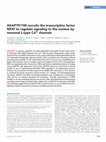
Molecular Biology of the Cell, Jul 1, 2019
In neurons, regulation of activity-dependent transcription by the nuclear factor of activated T-c... more In neurons, regulation of activity-dependent transcription by the nuclear factor of activated T-cells (NFAT) depends upon Ca 2+ influx through voltage-gated L-type calcium channels (LTCC) and NFAT translocation to the nucleus following its dephosphorylation by the Ca 2+-dependent phosphatase calcineurin (CaN). CaN is recruited to the channel by A-kinase anchoring protein (AKAP) 79/150, which binds to the LTCC C-terminus via a modified leucinezipper (LZ) interaction. Here we sought to gain new insights into how LTCCs and signaling to NFAT are regulated by this LZ interaction. RNA interference-mediated knockdown of endogenous AKAP150 and replacement with human AKAP79 lacking its C-terminal LZ domain resulted in loss of depolarization-stimulated NFAT signaling in rat hippocampal neurons. However, the LZ mutation had little impact on the AKAP-LTCC interaction or LTCC function, as measured by Förster resonance energy transfer, Ca 2+ imaging, and electrophysiological recordings. AKAP79 and NFAT coimmunoprecipitated when coexpressed in heterologous cells, and the LZ mutation disrupted this association. Critically, measurements of NFAT mobility in neurons employing fluorescence recovery after photobleaching and fluorescence correlation spectroscopy provided further evidence for an AKAP79 LZ interaction with NFAT. These findings suggest that the AKAP79/150 LZ motif functions to recruit NFAT to the LTCC signaling complex to promote its activation by AKAP-anchored calcineurin.
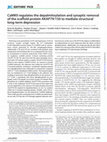
Journal of Biological Chemistry, Feb 1, 2018
Edited by F. Anne Stephenson Both long-term potentiation (LTP) and depression (LTD) of excitatory... more Edited by F. Anne Stephenson Both long-term potentiation (LTP) and depression (LTD) of excitatory synapse strength require the Ca 2؉ /calmodulin (CaM)-dependent protein kinase II (CaMKII) and its autonomous activity generated by Thr-286 autophosphorylation. Additionally, LTP and LTD are correlated with dendritic spine enlargement and shrinkage that are accompanied by the synaptic accumulation or removal, respectively, of the AMPA-receptor regulatory scaffold protein A-kinase anchoring protein (AKAP) 79/150. We show here that the spine shrinkage associated with LTD indeed requires synaptic AKAP79/150 removal, which in turn requires CaMKII activity. In contrast to normal CaMKII substrates, the substrate sites within the AKAP79/150 N-terminal polybasic membrane-cytoskeletal targeting domain were phosphorylated more efficiently by autonomous compared with Ca 2؉ /CaM-stimulated CaMKII activity. This unusual regulation was mediated by Ca 2؉ /CaM binding to the substrate sites resulting in protection from phosphorylation in the presence of Ca 2؉ /CaM, a mechanism that favors phosphorylation by prolonged, weak LTD stimuli versus brief, strong LTP stimuli. Phosphorylation by CaMKII inhibited AKAP79/150 association with F-actin; it also facilitated AKAP79/150 removal from spines but was not required for it. By contrast, LTD-induced spine removal of AKAP79/150 required its depalmitoylation on two Cys residues within the N-terminal targeting domain. Notably, such LTD-induced depalmitoylation was also blocked by CaMKII inhibition. These results provide a mechanism how CaMKII can indeed mediate not only LTP but also LTD through regulated substrate selection ; however, in the case of AKAP79/150, indirect CaMKII effects on palmitoylation are more important than the effects of direct phosphorylation. Additionally, our results provide the first direct evidence for a function of the well-described AKAP79/150 trafficking in regulating LTD-induced spine shrinkage.

Cell Reports, Mar 1, 2019
Long-term information storage in the brain requires continual modification of the neuronal transc... more Long-term information storage in the brain requires continual modification of the neuronal transcriptome. Synaptic inputs located hundreds of micrometers from the nucleus can regulate gene transcription, requiring high-fidelity, long-range signaling from synapses in dendrites to the nucleus in the cell soma. Here, we describe a synapse-to-nucleus signaling mechanism for the activity-dependent transcription factor NFAT. NMDA receptors activated on distal dendrites were found to initiate L-type Ca 2+ channel (LTCC) spikes that quickly propagated the length of the dendrite to the soma. Surprisingly, LTCC propagation did not require voltage-gated Na + channels or back-propagating action potentials. NFAT nuclear recruitment and transcriptional activation only occurred when LTCC spikes invaded the somatic compartment, and the degree of NFAT activation correlated with the number of somatic LTCC Ca 2+ spikes. Together, these data support a model for synapse to nucleus communication where NFAT integrates somatic LTCC Ca 2+ spikes to alter transcription during periods of heightened neuronal activity. In Brief Signaling from synapse to nucleus can alter transcription and consolidate long-term changes in neuronal function. Wild et al. uncover a mechanism for rapid long-distance signaling from distal dendrites to the nucleus that utilizes L-type voltage-gated Ca 2+ channel Ca 2+ spikes to activate the transcription factor NFAT.
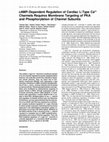
Neuron, Jul 1, 1997
studies demonstrated that cardiac L-type channel cur-* Department of Molecular Pharmacology rents... more studies demonstrated that cardiac L-type channel cur-* Department of Molecular Pharmacology rents are markedly increased by -adrenergic receptor and Biological Chemistry (-AR) agonists, and studies performed over the course Northwestern University Medical School of 20 years have strongly implicated that regulation oc-Chicago, Illinois 60611 curs through a cAMP-and PKA-dependent pathway that † Department of Pharmacology and Cell results in the phosphorylation of the channels or as yet Biophysics unidentified regulatory proteins (reviewed by McDonald University of Cincinnati College of Medicine et al., 1994; Hosey et al., 1996). Despite the extensive Cincinnati, Ohio 45267 study of this pathway, the specific in vivo phosphoryla-‡ Howard Hughes Medical Institute and tion events underlying channel regulation have not been Vollum Institute identified. Portland, Oregon 97201 L-type Ca 2ϩ channels are multisubunit complexes,

Journal of Biological Chemistry, May 1, 2015
Background: A-kinase anchoring proteins position signaling enzymes to control neuronal phosphoryl... more Background: A-kinase anchoring proteins position signaling enzymes to control neuronal phosphorylation events. Results: Biochemical and cellular approaches confirm that the AKAP79/150 signaling complex interfaces with the cytoplasmic tail of Roundabout (Robo) receptors. Conclusion: AKAP79/150-associated protein kinase C facilitates the phosphorylation of Ser-1330 on the Robo3.1 isoform. Significance: Kinase anchoring is a mechanism to control the phosphorylation of Robo3.1 within macromolecular assemblies. Anchoring proteins direct protein kinases and phosphoprotein phosphatases toward selected substrates to control the efficacy, context, and duration of neuronal phosphorylation events. The A-kinase anchoring protein AKAP79/150 interacts with protein kinase A (PKA), protein kinase C (PKC), and protein phosphatase 2B (calcineurin) to modulate second messenger signaling events. In a mass spectrometry-based screen for additional AKAP79/150 binding partners, we have identified the Roundabout axonal guidance receptor Robo2 and its ligands Slit2 and Slit3. Biochemical and cellular approaches confirm that a linear sequence located in the cytoplasmic tail of Robo2 (residues 991-1070) interfaces directly with sites on the anchoring protein. Parallel studies show that AKAP79/150 interacts with the Robo3 receptor in a similar manner. Immunofluorescent staining detects overlapping expression patterns for murine AKAP150, Robo2, and Robo3 in a variety of brain regions, including hippocampal region CA1 and the islands of Calleja. In vitro kinase assays, peptide spot array mapping, and proximity ligation assay staining approaches establish that human AKAP79-anchored PKC selectively phosphorylates the Robo3.1 receptor subtype on serine 1330. These findings imply that anchored PKC locally modulates the phosphorylation status of Robo3.1 in brain regions governing learning and memory and reward. Axonal guidance cues influence neuronal development by modulating local cell signaling events at growth cones of migrating neurons and at the postsynaptic densities of mature neurons (1-3). A common feature is the dissemination of extracellular signals through transmembrane receptor-associated complexes that include protein kinases and phosphatases (4-6). These anchored enzymes often reside on the inner face of the plasma membrane, where they respond to the generation of chemical second messengers, such as cyclic nucleotides, calcium, and phospholipids (7, 8). Scaffolding and anchoring proteins enhance the fidelity of this process by sequestering second messenger-responsive kinases and phosphatases within range of particular substrates (9). In some cases, the receptors are the substrates themselves. For example, A-kinase anchoring proteins (AKAPs), 2 a burgeoning family of intracellular proteins that sequester protein kinase A, have been shown to modulate the phosphorylation status and activity of several neuronal transmembrane receptors (10, 11). Subsequent work has shown that AKAPs coordinate higher order macromolecular complexes of PKA and other signaling molecules at defined subcellular locations (12, 13). Consequently, AKAPs augment the specificity of local cell signaling events by scaffolding protein kinases, phosphatases, phosphodiesterases, and small GTPases in proximity to upstream activators and within range of their downstream targets (14-17). Products of the AKAP5 gene encode a multivalent anchoring protein known as AKAP79/150 (note that AKAP79 is the human form and AKAP150 is the murine ortholog). AKAP79/150 organizes signaling enzymes that participate in the regulation of synaptic ionotropic and metabotropic glutamate receptors as well as other neuronal G-protein-coupled receptors (18-21). A principal molecular role of AKAP79/150 is to tether PKA, PKC, and PP2B within range of these receptors to control changes in synaptic strength. These local signaling events underlie aspects of hippocampal learning and memory and a myriad of other cellular functions (22, 23). In this report, we show that AKAP79/150 binds the Roundabout axon guidance receptors Robo2 and Robo3. AKAP150 co-distributes with both of these Robo receptors in the hippocampus and olfactory tubercle of adult mice. Biochemical and cell-based experiments confirm that the AKAP-Robo sub
Proceedings of the National Academy of Sciences of the United States of America, Jun 17, 2019
Cell Reports, Apr 1, 2017
Highlights d NMDA receptor activation of L-type Ca 2+ channels triggers Ca 2+ release from ER d E... more Highlights d NMDA receptor activation of L-type Ca 2+ channels triggers Ca 2+ release from ER d ER Ca 2+ depletion activates STIM1, which feeds back onto L channels to inhibit them d Activated STIM1 promotes L-channel-dependent growth in dendritic spine ER content d Activated STIM1 attenuates L-channel-dependent nuclear translocation of NFAT

Journal of Biological Chemistry, Mar 1, 1993
Muscarinic acetylcholine receptor subtypes (m1-m5) differentially regulate phosphoinositide-speci... more Muscarinic acetylcholine receptor subtypes (m1-m5) differentially regulate phosphoinositide-specific phospholipase (PLC) through the activation of distinct guanine nucleotide-binding (G) proteins which can be distinguished on the basis of their sensitivity to inhibition by pertussis toxin (PTX). In transfected Chinese hamster ovary cells, the m2 receptor subtype regulates the stimulation of PLC and inhibition of adenylyl cyclase (AC) through PTX-sensitive G proteins. In this study, we utilized the ability of cholera toxin (CTX) to ADP-ribosylate PTX-sensitive alpha subunits as part of the ternary complex formed by heterotrimeric G proteins and agonist-bound receptors to detect and characterize the interactions between transfected m2 receptors and endogenous G proteins in Chinese hamster ovary cells. In membranes derived from cells expressing the m2, but not the m3 receptor, the cholinergic agonist carbachol stimulated CTX modification of a 40-kDa species (G alpha 40). Importantly, similar carbachol dose dependence values and PTX dose sensitivities were observed for m2 receptor-mediated PLC signaling and G alpha 40-CTX modification. High resolution urea-SDS-polyacrylamide gel electrophoresis analysis revealed that G alpha i2 (40 kDa) and G alpha i3 (41 kDa) were components of the G alpha 40 identified by m2 receptor-dependent CTX modification. Furthermore, the sensitivities of G alpha i2 and G alpha i3 to PTX modification were determined to be the same as those for PTX inhibition of G alpha 40 labeling by CTX and m2 receptor-mediated PLC signaling. Similarly, agonist-induced desensitization of m2 receptor-G protein signaling required doses of agonist associated with stimulation of PLC. Desensitization involved receptor sequestration and down-regulation of G alpha i3; however, only the reduction of G alpha i3 required prior activation PLC signaling. Finally, desensitization of m2-G protein coupling could be partially mimicked by treatment with thapsigargin, an inducer of intracellular Ca2+ release, without altering the number of cell surface receptors or G protein levels. These results demonstrate that m2 receptors couple to both G alpha i2 and G alpha i3 in vivo and that this interaction is integral to both positive and negative regulatory pathways leading to activation of PLC and desensitization of receptor signaling.
Cell Reports, Mar 1, 2019
Highlights d Inhibitory synapses are composed of nanoscale subsynaptic domains (SSDs) d Gephyrin ... more Highlights d Inhibitory synapses are composed of nanoscale subsynaptic domains (SSDs) d Gephyrin and GABA A R SSDs closely associate and are dependent on each other d GABA A R SSDs are closely associated with presynaptic active-zone SSDs d Inhibitory synapses recruit additional SSDs during activitydependent growth
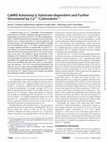
Journal of Biological Chemistry, Jun 1, 2010
A hallmark feature of Ca 2؉ /calmodulin (CaM)-dependent protein kinase II (CaMKII) regulation is ... more A hallmark feature of Ca 2؉ /calmodulin (CaM)-dependent protein kinase II (CaMKII) regulation is the generation of Ca 2؉independent autonomous activity by Thr-286 autophosphorylation. CaMKII autonomy has been regarded a form of molecular memory and is indeed important in neuronal plasticity and learning/memory. Thr-286-phosphorylated CaMKII is thought to be essentially fully active (ϳ70-100%), implicating that it is no longer regulated and that its dramatically increased Ca 2؉ / CaM affinity is of minor functional importance. However, this study shows that autonomy greater than 15-25% was the exception, not the rule, and required a special mechanism (T-site binding; by the T-substrates AC2 or NR2B). Autonomous activity toward regular R-substrates (including tyrosine hydroxylase and GluR1) was significantly further stimulated by Ca 2؉ /CaM, both in vitro and within cells. Altered K m and V max made autonomy also substrate-(and ATP) concentration-dependent, but only over a narrow range, with remarkable stability at physiological concentrations. Such regulation still allows molecular memory of previous Ca 2؉ signals, but prevents complete uncoupling from subsequent cellular stimulation. Ca 2ϩ /calmodulin (CaM) 2-dependent protein kinase II (CaMKII) can phosphorylate a large variety of substrate proteins and is a key player in many Ca 2ϩ-regulated cellular events (for review see Refs. 1-4). However, CaMKII is best know for its regulation of long term potentiation of synaptic strength (LTP) (5, 6), likely by increasing both number (7) and single channel conductance (8, 9) of synaptic AMPA-type glutamate receptors, and possibly by stimulating BDNF production (10, 11) (for review see Refs. 1-4). CaMKII autophosphorylation at Thr-286 generates Ca 2ϩ-independent autonomous activity (12-14), a process regarded as molecular memory (for review see Ref. 2) and indeed important in learning and memory (15). Phosphorylation in the activation loop is a necessary step to generate full activity of many kinases, including PKA, PKC, and several CaMKs (for review see Refs. 16, 17). By contrast, CaMKII is thought to be fully activated by Ca 2ϩ /CaM alone, without requirement for phosphorylation. Its Thr-286 is not

The EMBO Journal, Apr 15, 1998
Protein kinases and phosphatases are targeted through association with anchoring proteins that te... more Protein kinases and phosphatases are targeted through association with anchoring proteins that tether the enzymes to subcellular structures and organelles. Through in situ fluorescent techniques using a Green Fluorescent Protein tag, we have mapped membranetargeting domains on AKAP79, a multivalent anchoring protein that binds the cAMP-dependent protein kinase (PKA), protein kinase C (PKC) and protein phosphatase 2B, calcineurin (CaN). Three linear sequences termed region A (residues 31-52), region B (residues 76-101) and region C (residues 116-145) mediate targeting of AKAP79 in HEK-293 cells and cortical neurons. Analysis of these targeting sequences suggests that they contain putative phosphorylation sites for PKA and PKC and are rich in basic and hydrophobic amino acids similar to a class of membrane-targeting domains which bind acidic phospholipids and calmodulin. Accordingly, the AKAP79 basic regions mediate binding to membrane vesicles containing acidic phospholipids including phosphatidylinositol-4,5-bisphosphate [PtdIns(4,5)P 2 ] and this binding is regulated by phosphorylation and calcium-calmodulin. Finally, AKAP79 was shown to be phosphorylated in HEK-293 cells following stimulation of PKA and PKC, and activation of PKC or calmodulin was shown to release AKAP79 from membrane particulate fractions. These findings suggest that AKAP79 might function in cells not only as an anchoring protein but also as a substrate and effector for the anchored kinases and phosphatases.
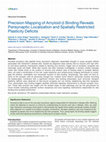
ENeuro, Nov 1, 2021
Secreted amyloid-b (Ab) peptide forms neurotoxic oligomeric assemblies thought to cause synaptic ... more Secreted amyloid-b (Ab) peptide forms neurotoxic oligomeric assemblies thought to cause synaptic deficits associated with Alzheimer's disease (AD). Soluble Ab oligomers (Abo) directly bind to neurons with high affinity and block plasticity mechanisms related to learning and memory, trigger loss of excitatory synapses and eventually cause cell death. While Abo toxicity has been intensely investigated, it remains unclear precisely where Abo initially binds to the surface of neurons and whether sites of binding relate to synaptic deficits. Here, we used a combination of live cell, super-resolution and ultrastructural imaging techniques to investigate the kinetics, reversibility and nanoscale location of Abo binding. Surprisingly, Abo does not bind directly at the synaptic cleft as previously thought but, instead, forms distinct nanoscale clusters encircling the postsynaptic membrane with a significant fraction also binding presynaptic axon terminals. Synaptic plasticity deficits were observed at Abo-bound synapses but not closely neighboring Abo-free synapses. Thus, perisynaptic Abo binding triggers spatially restricted signaling mechanisms to disrupt synaptic function. These data provide new insight into the earliest steps of Abo pathology and lay the groundwork for future studies evaluating potential surface receptor(s) and local signaling mechanisms responsible for Abo binding and synapse dysfunction.
Alzheimers & Dementia, Dec 1, 2022
Biophysical Journal, 2014

PLOS ONE, Aug 11, 2015
Alterations in lipid metabolism have been found in several neurodegenerative disorders, including... more Alterations in lipid metabolism have been found in several neurodegenerative disorders, including Alzheimer's disease. Lipoprotein lipase (LPL) hydrolyzes triacylglycerides in lipoproteins and regulates lipid metabolism in multiple organs and tissues, including the central nervous system (CNS). Though many brain regions express LPL, the functions of this lipase in the CNS remain largely unknown. We developed mice with neuron-specific LPL deficiency that became obese on chow by 16 wks in homozygous mutant mice (NEXLPL-/-) and 10 mo in heterozygous mice (NEXLPL+/-). In the present study, we show that 21 mo NEXLPL+/-mice display substantial cognitive function decline including poorer learning and memory, and increased anxiety with no difference in general motor activities and exploratory behavior. These neurobehavioral abnormalities are associated with a reduction in the 2-amino-3-(3-hydroxy-5-methyl-isoxazol-4-yl) propanoic acid (AMPA) receptor subunit GluA1 and its phosphorylation, without any alterations in amyloid β accumulation. Importantly, a marked deficit in omega-3 and omega-6 polyunsaturated fatty acids (PUFA) in the hippocampus precedes the development of the neurobehavioral phenotype of NEXLPL+/-mice. And, a diet supplemented with n-3 PUFA can improve the learning and memory of NEXLPL+/-mice at both 10 mo and 21 mo of age. We interpret these findings to indicate that LPL regulates the availability of PUFA in the CNS and, this in turn, impacts the strength of synaptic plasticity in the brain of aging mice through the modification of AMPA receptor and its phosphorylation.
Journal of Biological Chemistry, Mar 1, 2015
Background: K V channels in vascular smooth muscle cells (VSMCs) regulate arterial tone. Results:... more Background: K V channels in vascular smooth muscle cells (VSMCs) regulate arterial tone. Results: K V 2.1 in VSMCs is down-regulated via AKAP150-CaN-dependent NFATc3 signaling during diabetes. Conclusion: Transcriptional suppression of K V 2.1 contributes to enhanced arterial tone in diabetes. Significance: AKAP150-CaN-dependent activation of NFATc3 may be a general mechanism for transcriptional regulation of K ϩ channels, and a valuable target to prevent and treat diabetic vascular complications.

Uploads
Papers by Mark Dell'Acqua